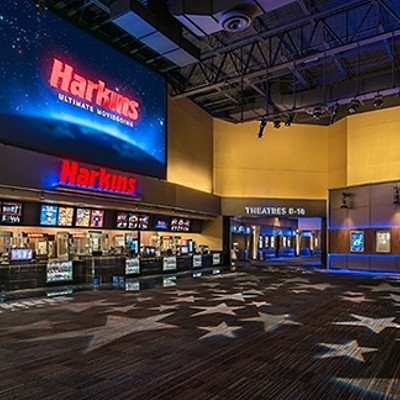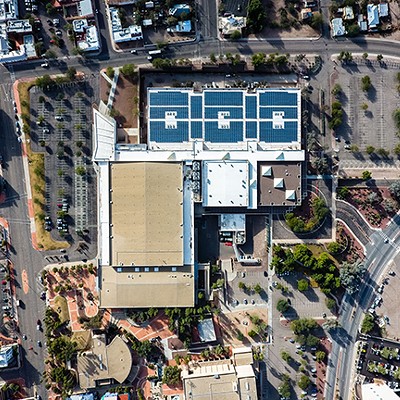The coffeehouse, owned by Baschelli's mom, opened about seven years ago, ahead of the current boom in the beachside town known affectionately as Rocky Point to gringo beachcombers who make the four-hour drive from Phoenix and Tucson.
"I've seen the changes," Baschelli says. "It's not stopping."
Today, there's a Burger King and Circle K alongside the taco stands and farmacias on Benito Juarez Boulevard, the town's main drag. Baschelli has heard that there's a McDonald's on the way, along with a Wal-Mart and a Home Depot.
"Will the white guys be standing out in front of Home Depot looking for work?" she wonders.
I've seen my share of changes during the last two decades or so that I've been visiting Rocky Point, as it's transformed from sleepy fishing village to tourist destination.
Sandy Beach, which used to be prime real estate for campers with a passion for speeding around in all-terrain vehicles, is now home to a 350-acre master-planned community of towering vacation condos, with more on the way. The eight-story buildings feature mammoth swimming pools, workout gyms and green lawns, along with on-site shops, restaurants and bars so the turistas don't ever have to leave the property. They can lounge on the beach beneath thatched ramadas, clamber aboard Jet Skis or take to the skies in parasails. And, of course, golfers can tee off on courses where the sun shimmers off man-made ponds scattered around the greens.
It's a short drive from Sandy Beach to the back end of Calle 13, a run-down avenue that has, in recent years, become home to a strip of topless clubs--another change in the last 10 years--and, at the Hotel Senorial, a sports book for gamblers who want to bet on horses, football, baseball and other professional sports. (They stopped taking action on the U.S. presidential race a few months ago; when I asked why, I only got a shrug from the indifferent hombres who run the joint.)
It'd be nice if the book was a more inviting place to watch a game (as it was when it first opened at the Vina del Mar Hotel), but there is one thing I continue to love about it: When they have to break the news to you that the game didn't go your way, they never say your ticket is a loser. It's always: "Not a winner."
As an old-school Rocky Pointer, I prefer to stay east of town in Las Conchas, a gringo neighborhood of vacation homes and condos, many of which are available as rentals. While it can be tough to find a decent and affordable place during the most popular months of the year, the beach is still remarkably deserted most of the days I'm down there.
With all of the development, water appears to be a problem in Las Conchas these days. When you check in at Oceano Rentals, you're given a warning that the community is suffering a severe water shortage, and visitors should keep their showers short and avoid flushing toilets unless necessary--not exactly the sort of message vacationers want to hear.
Homeowners in Las Conchas were recently assessed a fee of about $4,500 per home to build a desalinization plant for the community, but--like so much else in Rocky Point--the project has stalled. Yet the water woes don't seem to be slowing development at Las Conchas, where new houses are filling many of the empty lots. One resident estimates that in the last decade, the number of houses has doubled to about 400.
There's even a small condo tower going in behind the houses. Corona del Sol at Las Conchas features roughly 70 units in a cluster of four-story buildings. Residents can have it all: beach views, shared rooftops patios, a swimming pool, a putting green.
Charlotte Bohner, a real-estate manager with the project, says the project is modest compared to the towers going up elsewhere in the community.
Bohner tells me the Corona del Sol units, which start at $199,000 and go as high as $450,000, are selling fast. All the lowest-priced ones have already been snatched up.
Bohner, who has been visiting Rocky Point for decades, says the development has brought a lot of jobs to the town.
"It's building a wonderful middle class," she says.
Down the road at the Centro Intercultural de Estudios de Desiertos y Oceanos (or Intercultural Center for the Study of Deserts and Oceans), Alejandro Castillo is a bit more concerned about the impact of development.
Castillo, who came to Rocky Point from Puebla, Mexico, a few years ago to take a job as CEDO's sub-director, worries that developers don't always show concern about the environmental impact of their developments. Plans have been floated to build marinas in all six of Penasco's estuaries, which are vital spawning grounds for many species in the Gulf of California. And developers are planning nine golf courses, "which is completely stupid if you're in the desert," Castillo says.
Even CEDO, whose staff and volunteers have been studying the northern gulf for more than a quarter-century, has been threatened by development. Last year, during a property dispute, bulldozers started knocking down walls around the research facility to make room for a condo development. Although that crisis has been worked out (see "Shore Bet," Currents, June 7), CEDO is trying to raise a quarter-million dollars by the end of the year to resolve loose ends.
Castillo says that CEDO did a survey that showed there were more than 16,000 Rocky Point condos in the pipeline last year, says Castillo.
"It's really badly planned," he says. "We've offered our help, but they feel we're too environmental."
Back at Guiseppi's, Baschelli says she likes living in Rocky Point, though she doesn't spend much time in the local cantinas.
"When you live here, there are only so many nights you can go out drinking and partying," she says. "But when you're here on vacation, you can party all you want!"
Baschelli is OK with the town's changes. She remembers when Playa Encanto, a few miles down the coast from Las Conchas, was mostly empty beach. Now it's built up with houses and condos, and she's even picked up a wireless signal for an Internet connection out there.
Even if you're too distracted by browsing the Web to look at the beach, Baschelli says, "You can always put a picture of it on your laptop."















